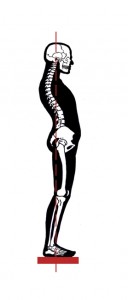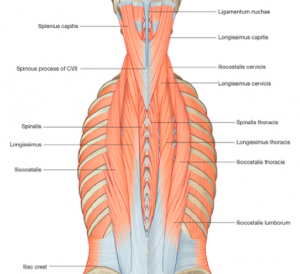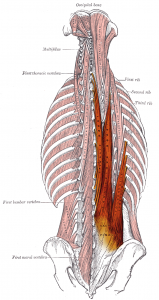The erector spinae is not just one muscle, but a group of paired muscles and tendons.
These ultra-important muscles run the length of the spine alongside the vertebral column.
There are three layers of muscle in the back and the erector spinae lie at the deepest level, covered by the thoracolumbar fascia at the base of the spine and by the nuchal ligament below the head.
We are looking at three muscles that can each be separated into three parts covering the lower, middle, and upper back.
The spinalis lies closest to the spine, the iliocostalis lies laterally to the spine and the longissimus is in between the two.
These muscles all have multiple origins and insertions along the vertebral column.
The erector spinea muscles all serve similar functions.
Working together they extend the spine and help to maintain erect posture; as well as stabilize the spine during flexion. Employed on one side they assist in side bending and rotation of the spine.
This grouping of muscles attaches from the sacrum to the head with connections to each of the vertebrae of the spine along the way.
While their function is to provide an upward lift or support to the spine, poor postural patterns interfere with, if not totally disrupt, the ability of the erector spinae to work as designed.
 The poor postural pattern I speak of is the one that I harp on most often—everyone leans backward when standing and walking.
The poor postural pattern I speak of is the one that I harp on most often—everyone leans backward when standing and walking.
The thing about the erector spinea is that though they are different muscles with many different origins and attachments they all depend on the tone of each other in order to function correctly.
The hallmark of the bad posture that I see consistently is the trunk leaning slightly backward compressing the bones of the lumbar spine and the muscles of the lower back including the erector spinae.
If the lower portion of the erector spinae muscles is aligned in the way I describe they will not be able to have the tone necessary to elevate the spine.
If the tone in the lower erectors is low, there is no way for the upper portions of these muscles to work properly either.
Forward head posture which I have been writing about a lot lately is one of the results of the erector spinae muscles that lack good tone.
If the muscles of the lower back can’t contribute to an elevation of the spine, the spine won’t elevate.
Changing our walking and standing posture is one of the only ways to get these muscles to work for us instead of against us.
***


